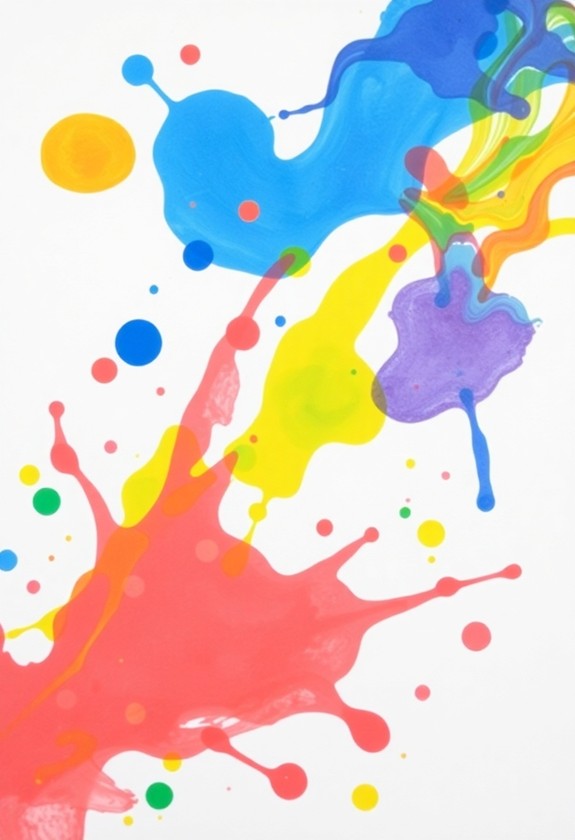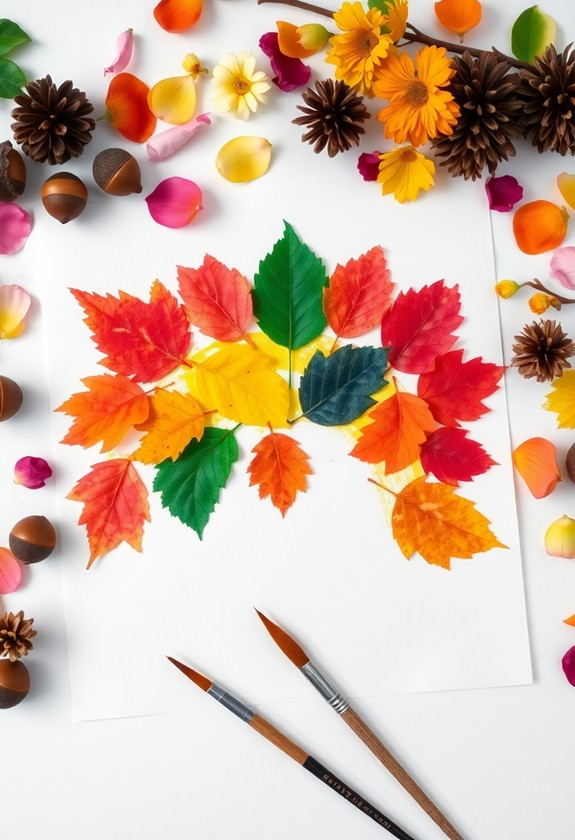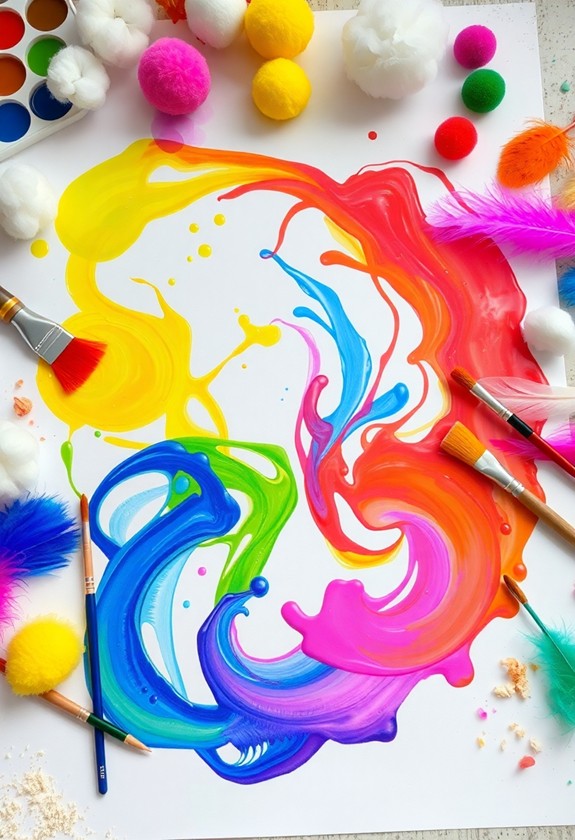Ready for some clean, creative fun with your toddler? Try these mess-free sensory art ideas! Shaving cream play offers a squishy delight, as no-mess finger painting in ziplock bags keeps things tidy. Sensory bags filled with colorful goop provide hours of tactile exploration. Get artsy with clean sand made from salt or sugar, creating lively designs without the grit. Mess-free play dough alternatives like cloud dough or kinetic sand offer moldable magic. And don't forget water play – it's a splashing good time with endless possibilities! These activities will spark your little one's imagination and develop their skills, all during keeping your home spick and span. Plunge in to uncover even more exciting ideas!
Creative Highlights
- Shaving cream provides a soft, squishy texture for sensory play and can be mixed with food coloring for marbled art.
- No-mess finger painting in sealed ziplock bags allows creative expression without cleanup.
- Sensory bags filled with colorful, squishy materials offer tactile stimulation and visual engagement for toddlers.
- Clean sand art using colored salt or sugar creates textured artwork without the mess of real sand.
- Water-based sensory bins with colored ice cubes and plastic toys encourage imaginative play and exploration.
Shaving Cream Sensory Play
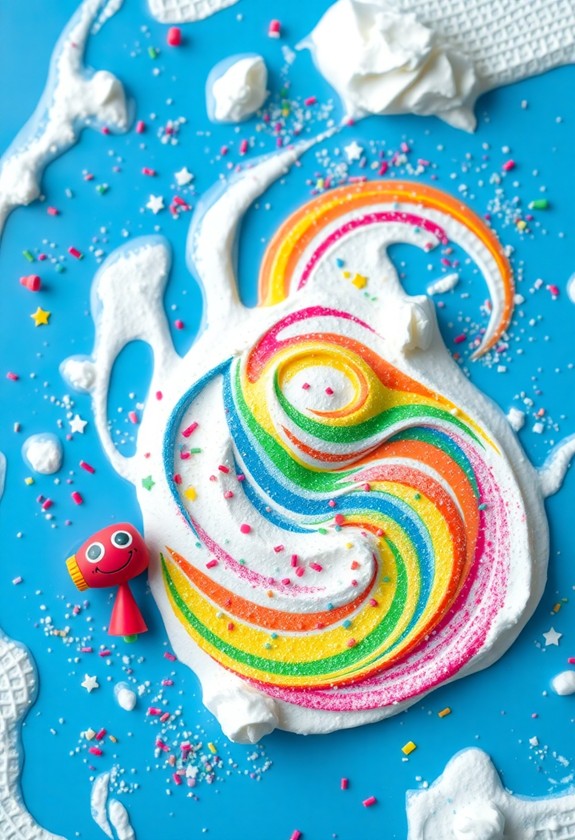
Shaving cream offers a delightful sensory experience for toddlers. It's soft, squishy, and oh-so-fun to play with! Here's how to set up this foamy adventure:
- Squirt shaving cream onto a tray or table
- Let your little one plunge into it with their hands
- Encourage them to spread, pat, and sculpt the cream
This mess-free art activity is perfect for developing fine motor skills and sparking imagination in children aged 3 and up. Unlike some art supplies, shaving cream is easy to clean up and won't leave stains on surfaces or clothing.
But wait, there's more! Add some colorful fun by mixing in a few drops of food coloring. Watch your toddler's eyes light up as they swirl the colors together, creating a marbled masterpiece!
For extra excitement, try these shaving cream shenanigans:
- Draw shapes or letters in the foam
- Use toy cars to make tracks
- Add plastic animals for a "snow day" scene
No-Mess Finger Painting
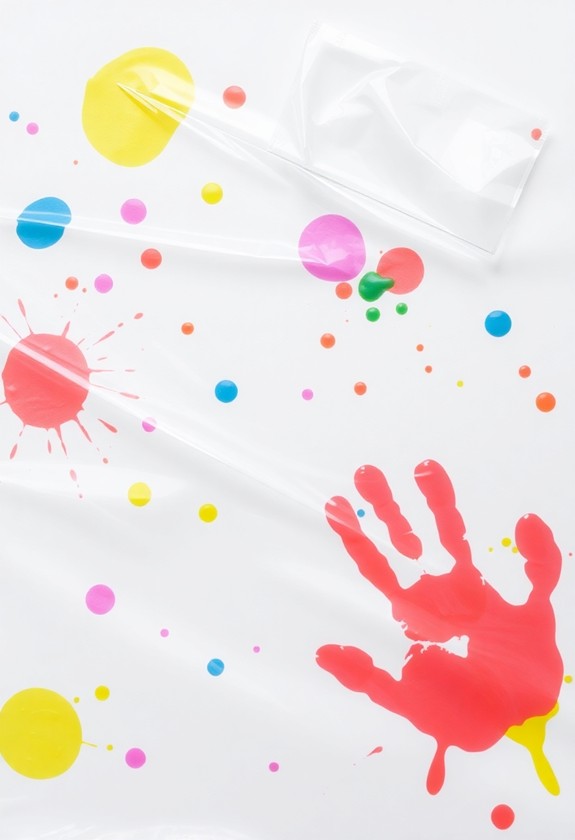
For parents who love art but dread the cleanup, no-mess finger painting is a game-changer. It's the perfect solution for creative play without the chaos! Here's how to do it:
- Grab a large ziplock bag
- Squirt in some washable paint (mix colors for extra fun!)
- Seal the bag tightly, squeezing out excess air
- Tape the bag to a flat surface
Now, let your little Picasso go wild! They can squish, smear, and swirl the paint around inside the bag. It's like magic – all the fun of finger painting without getting hands (or walls) messy! This non-toxic art activity promotes sensory exploration and cognitive development during keeping cleanup stress to a minimum.
Pro tip: Use this technique on windows for a stained-glass effect. Your toddler will be over the moon with their colorful creations, and you'll be thrilled with the easy cleanup. It's a win-win situation that'll have everyone finger-painting happy!
Sensory Bags for Toddlers
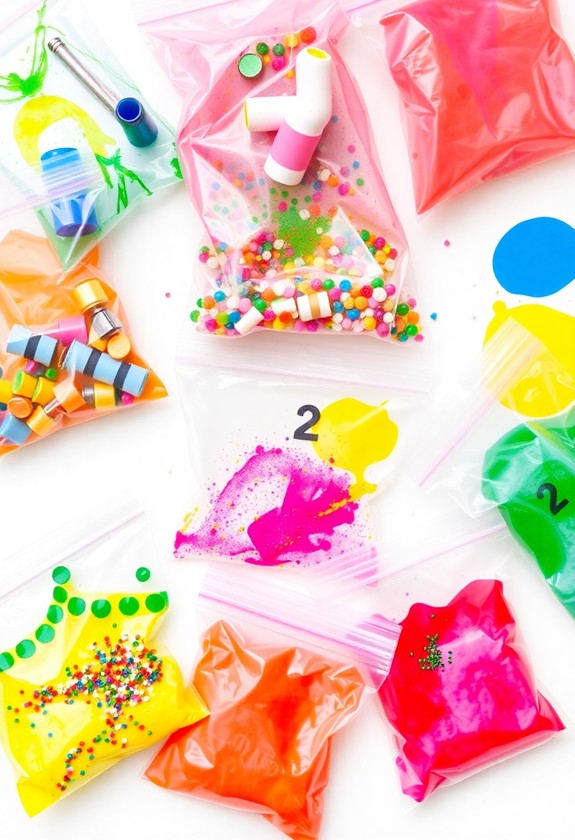
Speaking of contained creativity, sensory bags take the concept of no-mess play to a whole new level. These magical pouches are like mini-universes of fun for your little adventurer! Here's how to make them:
- Grab a sturdy, sealable plastic bag
- Fill it with colorful, squishy materials (think hair gel, paint, or shaving cream)
- Add fun objects like glitter, beads, or small toys
- Seal it tight and tape it down
Now, watch your toddler squish, squash, and uncover! They'll love the tactile sensations and visual stimulation. Plus, you'll love the easy cleanup. It's a win-win! For an extra touch of creativity, consider adding triangle-shaped crayons to improve grip and aid in writing skill development.
Pro tip: Create themed bags for holidays or seasons. A Halloween bag with orange goo and plastic spiders? Spooktacular! Or a spring-themed one with flower shapes and green gel? Blooming brilliant!
Clean Sand Art Activities
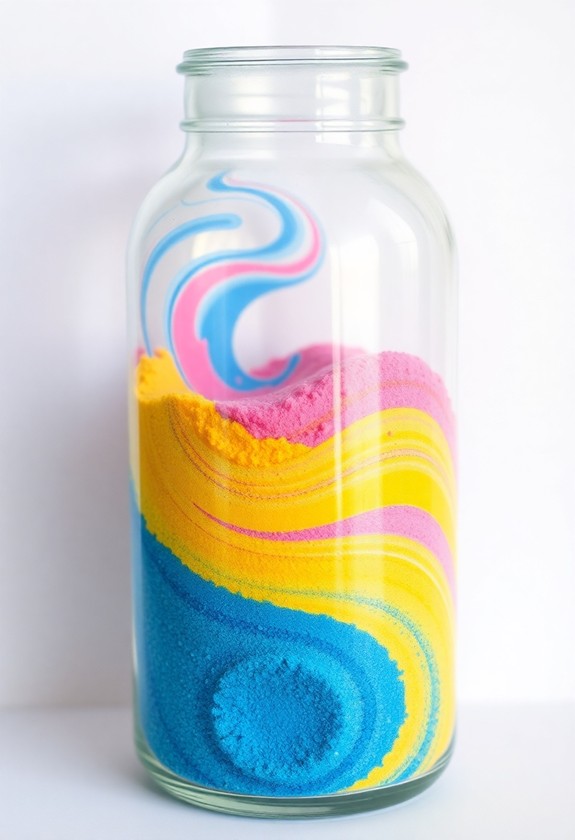
Clean sand art offers a delightful way for toddlers to explore textures and colors without the mess of traditional sand. It's a fantastic sensory experience that'll have your little one giggling with joy! You can create lively masterpieces using colored salt or sugar as your "sand." Here's how to get started:
- Gather colorful salt or sugar in small containers
- Provide paper with simple outlines or shapes
- Show your toddler how to sprinkle the "sand" onto glue
- Encourage experimentation with different colors and patterns
Watch as your child's eyes light up when they see their creation come to life! They'll love the feeling of the grainy texture between their fingers. And the best part? Clean-up is a breeze! You can even preserve their artwork by sealing it with clear spray adhesive. Get ready for some colorful, sandy fun!
Mess-Free Play Dough Alternatives
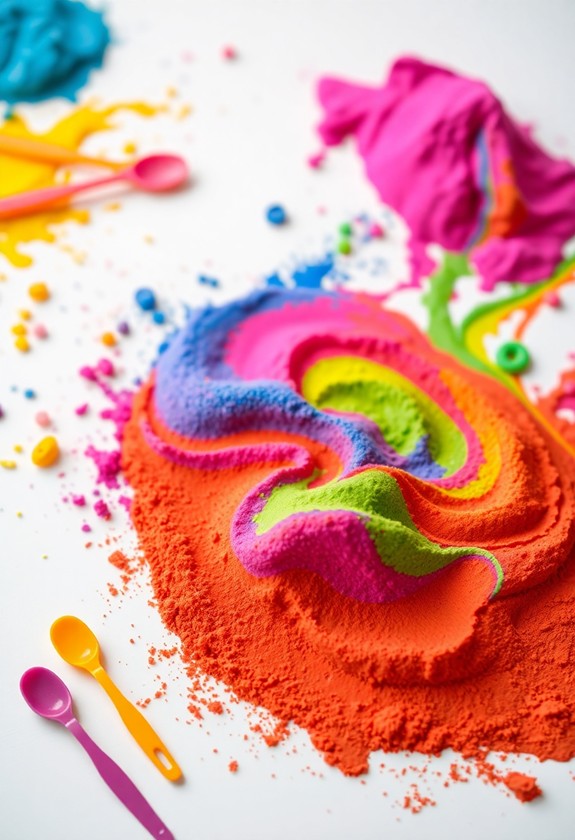
Parents often seek mess-free alternatives to traditional play dough for their toddlers' sensory art experiences. Don't worry, we've got you taken care of! Try these exciting options:
- Cloud dough: Mix 8 parts flour with 1 part baby oil for a moldable, crumbly delight!
- Kinetic sand: This amazing sand sticks to itself, not your hands or furniture!
- Silly putty: Stretch it, bounce it, mold it – the possibilities are endless!
- Foam dough: Combine shaving cream and cornstarch for a fluffy, squishy sensation!
These alternatives offer all the fun without the fuss! They're easy to make, clean up in a snap, and provide hours of sensory play. Plus, they're safe if accidentally ingested. Non-toxic ingredients are fundamental for toddlers' safety during art projects. Supervision is still vital to prevent messes and guarantee proper use. Your little one will love squishing, squeezing, and creating with these mess-free marvels. Get ready for some hands-on excitement!
Water-Based Sensory Exploration
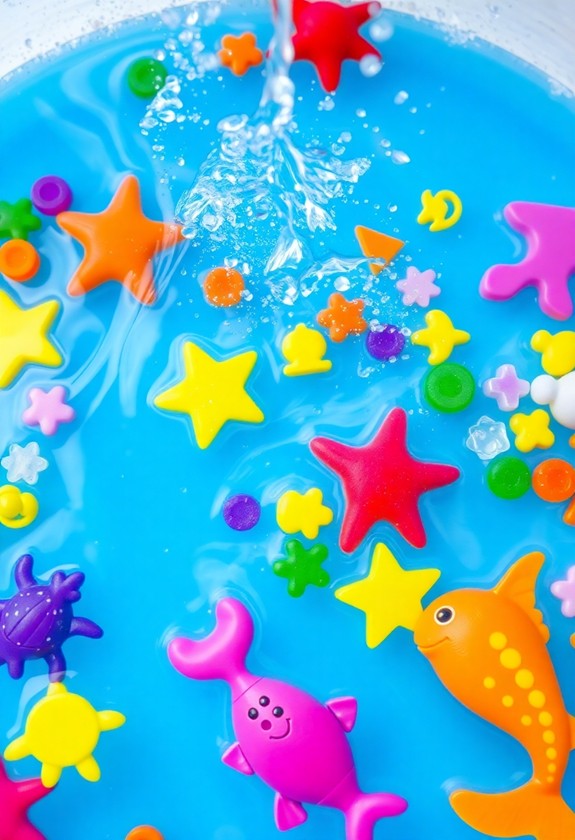
Water offers a world of sensory possibilities for toddlers. It's time to plunge into some splashy fun! You'll love these easy, mess-contained ideas that'll make your little one squeal with delight. For creative rainy day activities, water-based crafts are perfect for entertaining toddlers indoors. Try filling a clear plastic bin with water and adding:
- Colorful ice cubes (use food coloring for extra pizzazz!)
- Plastic sea creatures for an ocean adventure
- Measuring cups and funnels for pouring practice
- Sponges in various shapes for squeezing and squishing
But wait, there's more! Why not create a mini car wash with toy cars and soapy water? Or how about a floating masterpiece using watercolors on paper boats? The possibilities are endless! Remember to supervise closely and use warm water for comfort. Get ready to make a splash in the world of water-based sensory play – your toddler will be bubbling with excitement!
Curious Little Questions
What Age Is Appropriate to Start Sensory Art Activities With Toddlers?
You can start sensory art activities with toddlers as early as 6 months old! It's never too soon to engage those tiny hands and curious minds. By 12-18 months, your little Picasso will be ready for more advanced explorations. Remember, every child develops differently, so follow their lead. Start simple with finger painting or playdough, then gradually introduce new textures and materials. The key is to keep it fun, messy, and safe. Let their creativity bloom and watch their senses come alive!
How Can I Incorporate Educational Elements Into Clean Sensory Art Projects?
You can make sensory art a learning adventure! Try these fun ideas:
- Use colorful rice to practice counting and sorting
- Create shapes with playdough to teach geometry
- Spell words in shaving cream for early literacy
- Mix colors to investigate basic science concepts
Don't forget to name objects, describe textures, and ask questions as you play. It's a great way to build vocabulary and critical thinking skills. Remember, learning through art is all about having a blast during the growth of those little minds!
Are There Any Allergy-Friendly Alternatives for Common Sensory Art Materials?
You've got plenty of allergy-friendly options for sensory art fun! Try these awesome alternatives:
- Replace flour with cornstarch for gooey slime
- Use rice instead of sand for textured play
- Swap out Play-Doh for homemade salt dough
- Opt for water beads over small plastic pieces
And don't forget about natural materials! Leaves, twigs, and pebbles are fantastic sensory tools. Always double-check ingredients and supervise playtime. With these safe swaps, you'll be creating allergy-free masterpieces in no time! Let's get messy and creative!
What Precautions Should I Take When Introducing New Textures to Sensitive Toddlers?
You won't believe it, but just as you're reading this, your toddler might be ready for new textures! Here's how to introduce them safely:
- Start slow: Offer small amounts of new materials
- Watch closely: Observe your child's reactions
- Be patient: Don't force it if they're hesitant
- Use familiar items: Mix new textures with favorites
- Keep it clean: Make sure all materials are safe and non-toxic
- Praise exploration: Encourage their curiosity
How Often Should I Rotate or Change Sensory Art Activities for My Toddler?
You'll want to shake things up for your little adventurer! Aim to rotate sensory activities every 1-2 weeks. This keeps things fresh and exciting! But don't sweat it if your kiddo's obsessed with a particular activity. Let them enjoy it longer! Mix it up by:
- Introducing new textures
- Changing colors
- Trying different tools


